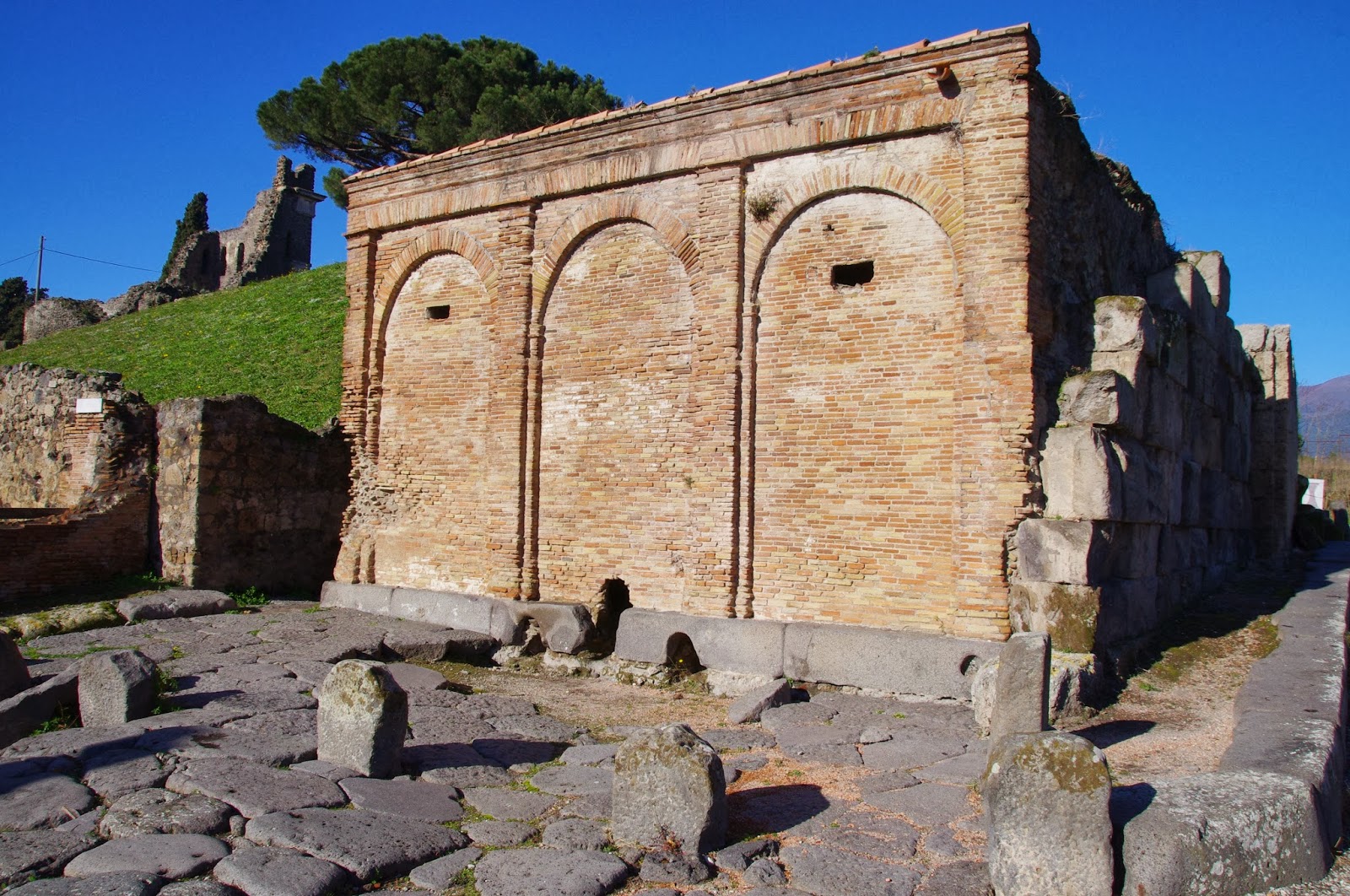The Necropoleis and Walls of Pompeii
The avenue that from Porta Ercolano leads to
the Villa of the Mysteries may be rightfully called a veritable Avenue of Tombs [Via dei Sepolcri]. On both sides outside the gate, the consular road
is flanked by tombs and funerary monuments, as it was customary outside of
Roman cities (Roman law did not allow the burial of the dead within the city
walls, therefore cemeteries had to be built outside, with the largest and
richest tombs located in prominent position along the main ways leading in and out of town). The Via dei Sepolcri is perhaps
the most famous of the cemeteries that are found outside the walls of Pompeii.
The necropolis of Porta Nola, Porta Nocera and Porta Vesuvio are also notable for their carefully arranged
funerary monuments. The tombs are an authentic “Who was Who?” of ancient Pompeii.
Here is found the tomb of Naevoleia Tyche and his husband, Caius
Munatius Faustus, a priest of the deified Emperor Augustus (Augustalis), who had likely made his
fortune through commerce as suggested by the beautiful bas-relief of a trading
vessel that decorates the side of the monument. Here are also the tombs of
Umbricius Scaurus, who organized gladiatorial games in the amphitheater; Marcus
Porcius, who dedicated the Odeion (Theatrum
Tectum) and the amphitheater (Spectacula);
and the priestess Mammia, to whom an inscription attributes the dedication of
the temple of Augustus in the Forum. Outside Porta Nocera we can find the tomb
of the Priestess Eumachia, undoubtedly one of the wealthiest and most powerful
women in Pompeii, who dedicated the building named after her in the Forum, in
addition to several statues of the Emperors Tiberius and Augustus. An
interesting inscription not far from her tomb, on what must have been a major
highway leading into town, sheds an interesting light into some very ancient Italian
malpractices. The inscription was commissioned by a certain, Titus Suedius
Clemens, a tribune, and reads “EX AUCTORITATE IMP CAESARIS VESPASIANI AVG LOCA
PVBLICA, A PRIVATIS POSSESSA T SVEDIUS CLEMENS TRIBVNVS CAVSIS COGNITIS ET
MENSVRIS FACTIS REI PUBLICAE POMPEIANORVM RESTITVIT”, meaning “By virtue of authority conferred upon him by
the Emperor Vespasian Caesar Augustus, Titus Suedius Clemens, tribune, having
investigated the facts and taken measurements, restored to the citizens of
Pompeii public places illegally appropriated by private persons”. Already in 79 AD Italy private abuse was quite
widespread if it took the authority of the Emperor to restore public ownership
of communal land.
 |
| Some of the tombs were of truly monumental proportions and often contained the remains of entire families across many generations. [Photo by Author] |
 |
| Many of the tombs were richly ornamented with stuccoes and paintings. Some also contained benches for the rest of travellers and wayfarers. [Photo by Author] |
 |
| Given its proximity to Mount Vesuvius, the Necropolis of Porta Ercolano suffered the full intensity of the pyroclastic flows ejected by the volcano. [Photo by Author] |
 |
| One of the most ornamented tomb stones is that belonging to Naevoleia Tyche, undoubtedly one of the wealthiest and most powerful women in Pompeii. [Photo by Author] |
Not less interesting, outside of Porta Vesuvio,
is the Tomb of Vestorius Priscus.
The man, who died at the age of 22, held the office of Aedile, which was a minor
city magistrate in charge of the construction and maintenance of public
buildings. Among the several painted scenes that decorate the tomb, three are
particularly notable. The first one shows the deceased, Vestorius Priscus, in
his office of magistrate facing an audience. The second shows a remarkable
still life of silver vessels, carefully laid on a table. These include
beautiful inlaid cups, plates, saucers and spoons. It is the third scene,
however, which is perhaps the most interesting: it shows a pair of fighting
gladiators, wearing the weapons of the thraex
and the hoplomachus. The winner
is standing, while his opponent lies to the ground still holding to his shield.
Quite interestingly, both gladiators seem to be wearing a very fine tunic made
of a translucent material similar to silk. The fresco is thought to memorialize
a munus offered by Vestorius Priscus
in the amphitheater of Pompeii when he was an Aedile.
The Walls
of Pompeii are perhaps its most overlooked monument. The walls are over 3 Km in
length, pierced by 7 gates and protected by towers, of which the Tower of Mercury is perhaps the most
famous. The walls bear all the signs of a protracted siege by the troops of
Sulla during the Roman civil war. The walls, whose construction probably dates
to the Samnitic period, are built of large volcanic tufa blocks, and were later
elevated with the addition of towers when Pompeii became a Roman colony. The
surviving towers were as much as 3-Storeys high, with arched windows for
artillery. Several graffiti and quarry marks can still be found on many of the
stones that compose the walls.









No comments:
Post a Comment